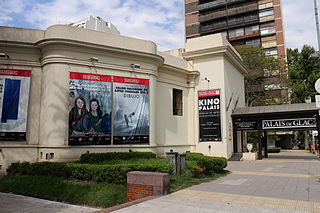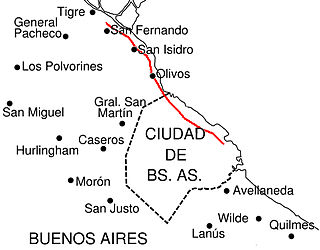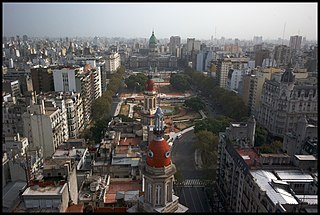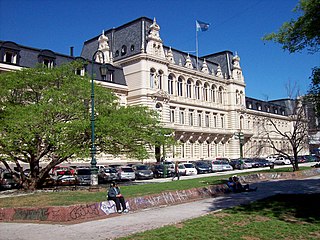
The Monumento ecuestre a Carlos María de Alvear located on Plaza Julio de Caro, a landmark in the Recoleta neighbourhood of Buenos Aires, Argentina, and was raised in honor of Carlos María de Alvear (1788-1852). [1]

Recoleta is a downtown residential neighborhood in Buenos Aires, Argentina. It is an area of great historical and architectural interest, due to its Beaux-Arts architecture as well as the distinguished Recoleta Cemetery. It is also an important tourist destination in the city.

Buenos Aires is the capital and largest city of Argentina. The city is located on the western shore of the estuary of the Río de la Plata, on the South American continent's southeastern coast. "Buenos Aires" can be translated as "fair winds" or "good airs", but the former was the meaning intended by the founders in the 16th century, by the use of the original name "Real de Nuestra Señora Santa María del Buen Ayre". The Greater Buenos Aires conurbation, which also includes several Buenos Aires Province districts, constitutes the fourth-most populous metropolitan area in the Americas, with a population of around 15.6 million.

Argentina, officially the Argentine Republic, is a country located mostly in the southern half of South America. Sharing the bulk of the Southern Cone with Chile to the west, the country is also bordered by Bolivia and Paraguay to the north, Brazil to the northeast, Uruguay and the South Atlantic Ocean to the east, and the Drake Passage to the south. With a mainland area of 2,780,400 km2 (1,073,500 sq mi), Argentina is the eighth-largest country in the world, the fourth largest in the Americas, and the largest Spanish-speaking nation. The sovereign state is subdivided into twenty-three provinces and one autonomous city, Buenos Aires, which is the federal capital of the nation as decided by Congress. The provinces and the capital have their own constitutions, but exist under a federal system. Argentina claims sovereignty over part of Antarctica, the Falkland Islands, and South Georgia and the South Sandwich Islands.
Contents
It is a work by French sculptor Antoine Bourdelle. It is considered by the author as his masterpiece in the great monuments.
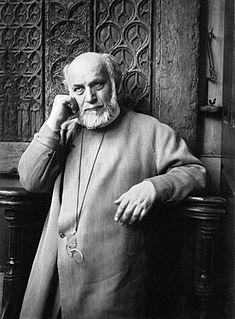
Antoine Bourdelle, born Émile Antoine Bordelles, was an influential and prolific French sculptor and teacher. He was a student of Auguste Rodin, a teacher of Giacometti and Henri Matisse, and an important figure in the transition from the Beaux-Arts style to modern sculpture.
In 1912, Rodolfo Alcorta, a friend of Bourdelle, invited the sculptor to participate in a concours for the realization of this monument. He received the commission in 1913. [1] The author took nearly ten years to complete the sculpture. Once finished the monument was shipped to Buenos Aires from France in 1925.
The sculpture and the pedestal of polished pink granite adorned with additional bronzes by the artist, stands in its current location since 12 October 1926. [1]
